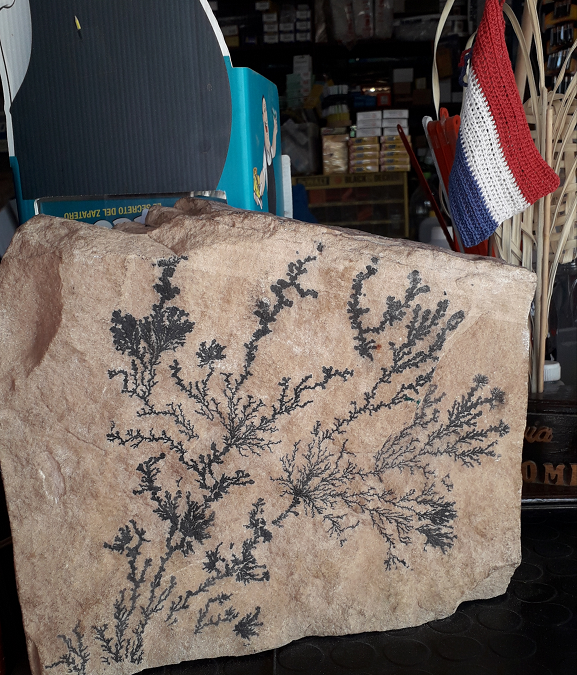The rocks that underlie central South America are on the whole stable and ancient. These rocks know as craton represent old stable continental crust that has remained unaltered through eons.
As might be expected though this does not represent the full story. Here in Paraguay those old craton rock have in places been intruded through by volcanic rocks and in other areas overlaid by younger sedimentary rocks.
Not far from where are live are a number of conical peaks representing the cores of long dead volcanoes. It has been many millions of years since the rocks of Paraguay were last volcanicly active. Now just the battered remains of these long dead volcanoes stand out above the flatlands.
The geology is quite different up amongst the low hills of my local environment. Here although some volcanic features are evident the majority of the bedrock is sedimentary. The rocks beneath my feet are the same as those that rise as sheer cliffs on the opposite side of the valley. These rocks are on the whole sandstone.
Those sandstone rocks could not have been formed where they now lie. Three hundred metres above sea level and almost that distance above the flood planes of the rivers that now run through Paraguay. Sandstone is laid down layer upon layer under water. Most commonly in lakes or as rivers slow down dropping their cargo of silt.
Clearly then the landscape of Paraguay has not always looked like is does now. Generally flat, rising to the north and with just a couple of regions of higher ground.
Another clue to the origins of the rocks comes from a quarry up in the hills from which building stone is extracted. There amongst the quarried stone fossils can be found. These are of plants rather than animals. The most common show the waving branches of corals or sea ferns. These would suggest the stationary waters of a warm shallow lake rather than those of a flowing river.
I have a few examples I have acquired over the years around the house. The largest and best preserved specimen on display locally is on show at one of the builders merchants in Piribebuy. That is nearly half a metre in diameter and clearly shows the black of the fossil against the orange of the rock.
A natural further question is quite what aquatic fossils are doing in a hilltop quarry.
The answer is a combination of two of the earths great sculpting forces. Firstly plate tectonics to lift the land mass as a whole and drain away any inland seas. Then erosion to wear down the weaker bands and layers of the sandstone to leave behind the landscape as seen today.
The forces the pushed up the Andes would have sent pressure waves across the whole of South America. Lifting and crumpling rocks as they went. This is why the highlands in Paraguay tend to run north south.
There is also the evidence still to be seen of the millions of years of erosion that then wore down those new hills. All across Paraguay there are deep wide valleys through which run streams seemingly far too small for the valleys the occupy.
After the once a year torrential storm returns these streams for a few hours to the rivers they may once once have been. Deep and fast flowing tearing at their banks and uprooting trees.
In wetter times the land may have been crossed by many more great rivers than it is now. Cutting down though the softer layers of sandstone to create the valleys same streams now inhabit. Additionally heavier rains means more water running off the hilltops eroding the hillside as it goes.
Evidence of this erosion is visible everywhere. The thick, heavy orange soil that covers Paraguay is the remains of hills that once stood across it. Sand laid down either by slowing rivers or as soil washed into lakes compressed over time into rock. This rock became uplifted before being worn down once more to sand and dust so that the cycle can repeat itself.
One final thing to be said about the sedimentary rocks of Paraguay is that in places they resemble rock formations elsewhere in the world that lie on top of reserves of hydrocarbons. With this knowledge geologists have been prospecting across Paraguay for more than a hundred years in search of oil.
As yet nothing of commercial value has been uncovered. But the search still goes on.


You seem to know a lot about geology Simon. Maybe sometime you can add a post about the different soil types found in Paraguay, red, brown, white. For example, in my region it’s all red soil. They say potatoes are one of the few things that can’t grow here.
The other day, I took my car to a lavadero and he asked if I was from San Pedro de Paraná which is a small town. I said no, but I had just driven through there and asked how he knew. He said that the white dust on my car could only come from there or the Chaco.
Always had a bit of a thing for geology. Still got boxes of British rocks and fossils.
Writing about the different soils is yes something I could look into.
Around here it is just red, high iron content and then in swampy areas black, high organic content.
Am told that the black soil is the stuff for potatoes.
Very interesting